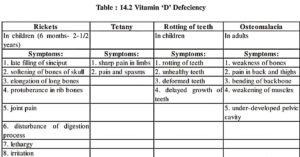Vitamin D – Functions, Food Sources, Deficiencies and Toxicity
Vitamin ‘D’—
- Vitamin D is an important fat-soluble vitamin. This vitamin works against bone deformities.
Types of vitamin D—
- Rickets resistant substances and sterol compounds are combined together to form vitamin D.Vitamin D is of two main types

- Vitamin D2 — It is called Ergosterol or provitamin D. it reacts with ultraviolet rays of sun to form Calciferol. It is found in mold and yeast.
- Vitamin D3 — it is also called 7- dehydrocholesterol. It is present under the skin and reacts with ultraviolet rays of sun to get converted into vitamin D
Functions of vitamin D—
- Helpful in absorption of calcium and phosphorous— Vitamin D controls the amount of alkaline phosphatase enzyme which helps in increasing the absorption rate of calcium and phosphorous by bones. In the absence of vitamin these mineral salts are not absorbed. As a result much of calcium and phosphorus gets removed from the body.Consequently bones and teeth do not develop properly.
- Controlling the amount of calcium and phosphorus in blood— Vitamin D controls the amount of calcium and phosphorous in the body. When both these minerals are in lesser quantity in blood, they move from bones into the blood and thus maintain the balance of calcium and phosphorous levels in blood.
- For physical growth— vitamin D plays an invaluable role in physical growth and development. Deficiency of this vitamin reduces the absorption rate of calcium and phosphorus and physical growth is affected.
- Controlling parathyroid gland – vitamin D controls and regulates the secretion of hormones from parathyroid gland.
- Vitamin D helps in synthesizing the activity of protein in mucosa of small intestine.
Effects of deficiency of vitamin D—
Deficiency of vitamin D leads to increased levels of alkaline phosphatase in blood. As a result, calcium and phosphorous do not get absorbed properly in the intestines. Thus the bones and teeth become weak. Following disorders occur due to deficiency of vitamin D—
- Rickets— It commonly affects children. In this disorder, there is an acute deficiency of vitamin D, calcium and phosphorous in the body. It mainly affects people living in populated, industrial areas where they do not get proper sunlight.
- Muscle twitching— Deficiency of vitamin D causes irregularity in metabolism of calcium and phosphorus and this leads to muscle twitching.
- Teeth rotting— Deficiency of vitamin D teeth delays teeth growth in children. Calcium phosphate does not get deposited in enamel and dentin of teeth. Thus Healthy teeth are not formed.
- Osteomalacia— it is a term for rickets in In this disorder bones become soft and get adults. In this disorder, due to deficiency of bent. Bone breaking becomes common. vitamin D or calcium thus calcification in bones
- Osteoporosis— it commonly found in adults does not take place properly. It is common in where bones grow weak and disabled. Bones pregnant and feeding mothers who mostly take break on slightest injury or fall. plant-based food and stay confined in houses.

Effects of excess of vitamin D—
- Excess of vitamin D causes loss of appetite, nausea, vomiting, thirst and diabetes insipidus. A child feels lethargic and weak and deterioration of muscles. Exc arteries, kidneys and lungs leading to death. of vitamin D causes calcium deposition in
Sources of vitamin D—
- Vitamin D is present in only some animal based food products. Vitamin D is obtained from sunlight and from sources such as liver oil of fish, fat-rich fishes, eggs, butter, cottage cheese, fat-rich milk, etc.
Home Science Latest Post :- Click Here
Vitamins Questions and Answers :-
Que1. Which of the given was invented by Kazimierz Funk?
(a) Enzymes
(b) Hormones
(c) Vitamins
(d) Proteins
Click to show/hide
Ans. ⇒ { c }
Que2. What type of compounds are Vitamins?
(a) Organic Compound
(b) Inorganic Compound
(c) Living Organisms
(d) None of the above
Click to show/hide
Ans. ⇒ { a }
Que3. Which is also known as the “Accessory dietary factor”?
(a) Fats
(b) Vitamins
(c) Proteins
(d) Hormones
Click to show/hide
Ans. ⇒ { b }
Que4. Which is not an essential element for plant growth?
(a) Potassium
(b) Calcium
(c) Magnesium
(d) Sodium
Click to show/hide
Ans. ⇒ { d }
Que5. Which of the given has the highest calorie value per unit?
(a) Vitamins
(b) Proteins
(c) Fats
(d) Carbohydrates
Ans. ⇒ ????
